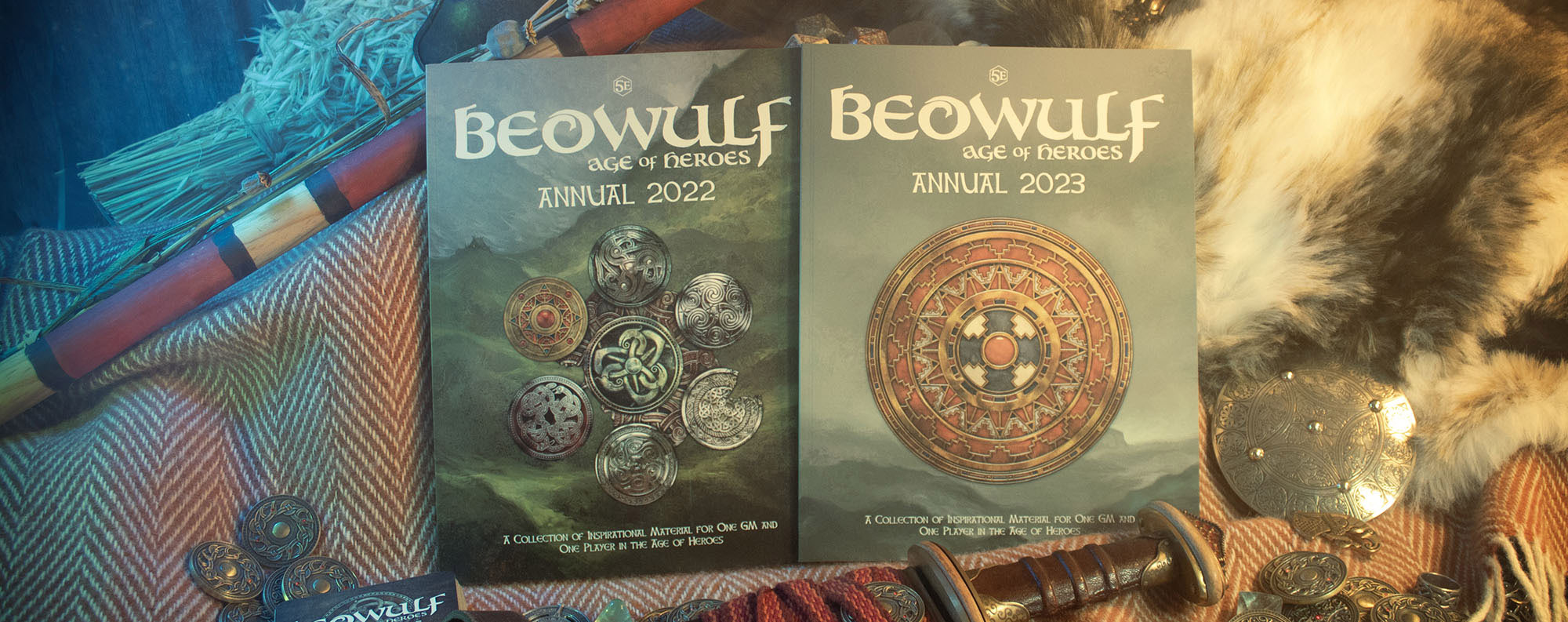Religion in BEOWULF
The world described in Beowulf is one of long ago, written down somewhere around 800AD, that harked back to an even earlier mythic time.
Scholarly opinions differ about many aspects within that original Beowulf text – the old fashioned or traditional view is that it is an ancient “pagan” tale given a Christian gloss.
More recent theories suggest it was produced for pay by clerics working for Christians of Nordic heritage who paid for such flattering tales of their ancestors. Others yet suggest the deeds of Beowulf were an allegory of Christ: We know that Beowulf was read by Anglo-Saxon Christian clerics in a religious context, since their contemporaries complained about it in surviving written sources.
But there is little doubt that an older pagan world wrestled with the newer Christian faith within the text.
And so it is that the game BEOWULF includes both monotheistic, Christian and polytheistic Pagan* characters. And indeed, those whose philosophical allegiances lie somewhere in between.
We’ve taken up an idea most clearly expressed by JRR Tolkien in his seminal essay “The Critics and the Monsters”, that Beowulf attempts to encompass two competing world views:
The older, more melancholic, Nordic pagan tradition believed that the world was doomed to be devoured by monsters, and all a hero could do was hope to be remembered in tales after a glorious death. Personal strength, honour, and heroism in defeat were pagan ideals.
This contrasted with the more hopeful message of Christianity. That with the help of the Christian god, monsters could be ultimately defeated. This was a new and radical idea, which was heroic in a different way.
These two philosophies can both be attractive to the heroes of BEOWULF, the game. And our mechanics reflect this.
In BEOWULF, 5e alignment is replaced with the alignment of a hero’s faith, whether it is Pagan, Christian or something in between: for example, at one time the Anglo-Saxon King of Kent was known to keep both a Christian and a Pagan altar in his place of worship, and indeed the famous Sutton Hoo ship burial is full of both Christian and Pagan artefacts.

We’ve taken great pains to avoid the obvious cliches around this topic – the neo-pagan ideas that spring from the hippy movement and Victorian Romanticism, and the cliches arising from later stages of sword-point Christian conversion and much later obsession with hellfire and damnation.
We’ve really focused on what we regard as a more interesting time that predates both these cliches. Our focus is about understanding these two philosophies and why people believed them, all in the service of heroic, storybook tales for your character.

Mechanically, Pagans in BEOWULF can expect a boost when things are going wrong, and there is a chance to exercise awesome doomed heroism. Conversely, heroes of a Christian persuasion benefit from their positive attempts to overcome the dark, and the communal nature of early Christianity.
Where and how each faith gains inspiration is different, and built to reflect their nature. Playing the same scenario as a Pagan, a Christian, or someone who’s faith is pragmatically undecided will give a different feel, and a different result. And we hope you’ll want to try out all the options.
We’ve tied our alignment to the advantage and disadvantage mechanics, in what we think is a really integrated way, giving each type of character a different feel in play. In BEOWULF generally, inspiration plays a much larger part than the typical 5e game, and really drives heroic play.
Religion is, of course, an important and sensitive topic in the real world. In our game, and all faiths are depicted as “storybook” versions of real-world religions, with the purpose of creating great mythical characters that feel like those we find in the poem Beowulf, both Pagan and Christian.
And so, you may choose to play a traditional pagan hero who is testing their personal strength and doing their best to win a famed and glorious death worthy of being remembered in song.
Or perhaps a muscular Christian traveller bringing light to the dark places of a mythical Northern Europe, battling the Children of Cain with their bare hands?
But the world of BEOWULF is a tangled one. Sometimes Christians will find themselves in places of great Pagan power and vice versa, and they may not be able to rely on… well, anything.
Our design team are neither Christians nor Pagans, but have been greatly inspired by the dualistic spirit of this fascinating poem, and how it reflects the tangle of changing faiths in the mythic world of long ago.
Through careful research and a firm belief in giving you the tools to create your own adventures faithful to the spirit of Beowulf, we really hope you’ll enjoy the mythical and story book world we’re creating for one player and one GM, using Fifth edition.

*we recognise that the term “Pagan” can carry negative connotations, and indeed was originally a term of disparagement. We use it here as an atmospheric and thematic term, and without any inferred judgement on historical or contemporary faiths.

